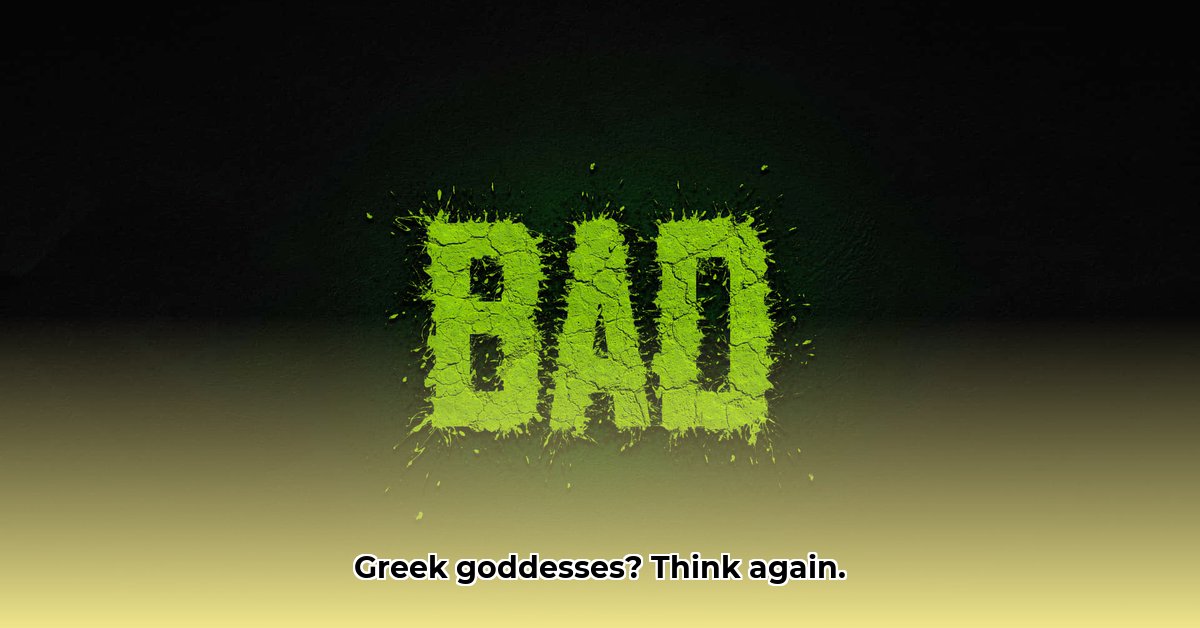Forget the sugar-coated tales of virtuous goddesses and docile heroines. Lizzy Tiffin’s Bad Girls of Ancient Greece detonates conventional mythology, revealing the captivating stories of women who dared to defy ancient Greek societal expectations. It’s a refreshing, humorous, and profoundly insightful exploration, serving as a launchpad to critically examine how these women carved out agency in a world dominated by men. For more on women in ancient Greece, check out this helpful resource: Ancient Greece Women.
Redefining “Bad”: A Feminist Perspective on Ancient Greece’s Forgotten Women
Bad Girls of Ancient Greece isn’t just another retelling of dusty myths; it’s a radical reimagining of legendary women, offering a modern, engaging, and often uproariously funny narrative. Names like Medea, Clytemnestra, and Circe, traditionally associated with wickedness and villainy, are re-examined through a feminist lens, revealing their motivations, complexities, and the societal pressures that shaped their choices. These are potent examples of female agency and ancient wisdom. Tiffin skillfully unveils them, not simply as evil, but as women reacting to a deeply entrenched patriarchal system, navigating a world stacked against them at every turn. What series of events led them to make these choices, and can we identify corresponding patterns in today’s society?
Tiffin’s brilliance shines through in her conversational, relatable style, akin to chatting with a witty and knowledgeable friend rather than enduring a dry academic lecture. Complicated historical events and mythological intricacies are explained in an accessible manner, making the material engaging and enjoyable even for those completely unfamiliar with Classical literature. It’s a smart, funny, and seriously captivating read which creates mythological analysis that is exceptionally readable.
Let’s consider a balanced perspective on the book’s strengths and weaknesses:
- Accessible Feminist Perspective: Tiffin’s work presents a fresh and accessible perspective on often marginalized or completely overlooked female figures in Greek mythology.
- Narrative Reframing: She skillfully challenges traditional patriarchal narratives, promoting diverse viewpoints and interpretations.
- Potential Oversimplification: Limitations might include a lack of visual aids and a potential for oversimplification regarding the complexity of certain characters and historical contexts.
However, the exploration shouldn’t stop with Tiffin’s book. Numerous other underrepresented women from ancient Greece deserve recognition and in-depth analysis. Their stories, far too often told through a male lens, obscure their agency and motivations, demanding critical examination to uncover their full narratives. These “bad girls” represent a far wider range of female experiences, often meticulously hidden within the historical record.
Tiffin’s work serves as a catalyst, encouraging a critical re-examination of ancient texts and historical sources. What specific aspects of their narratives have been ignored, dismissed, or minimized? What were the real reasons that fueled and motivated their actions? By asking these questions, we can move towards a far more rounded and complete understanding of these remarkable women, offering insightful analysis and crucial mythological context.
The notion of “badness” often attributed to these women often reflects the deeply ingrained patriarchal societies that sought to control and, ultimately, silence them. Their struggles against relentless power and restrictive societal expectations resonate profoundly even today, serving as a stark reminder of the enduring fight for equality and justice. “The stories of these women resonate because they highlight the enduring struggle for equality and justice,” said [Dr. Emily Wilson, Professor of Classical Studies], [University of Pennsylvania]. Their stories remind us that those who dare to challenge the status quo are all too often labeled as outsiders, troublemakers, or even dangerous – a challenge to traditional values that remains powerfully relevant across millennia.
By reclaiming their stories, meticulously researching historical contexts, and truly understanding their motivations, we gain a far richer appreciation for the profound complexity of ancient Greek society and the enduring power of female resilience. Let’s move beyond seeing these women solely through the reductive lens of their supposed “villainy” and instead dedicate ourselves to understanding them, celebrating their inherent strength and agency. They were complicated, multi-faceted women navigating a world designed to oppress and marginalize them, often against truly insurmountable odds. Their stories deserve to be told with empathy, understanding, and a healthy, generous dose of feminist perspective.
Integrating Bad Girls of Ancient Greece into the Classroom: A Rich Resource for Educators
Lizzy Tiffin’s Bad Girls of Ancient Greece provides a fresh and incredibly accessible perspective on these often-overlooked or misrepresented female figures. It is a particularly unique and valuable resource that can be powerfully utilized in a modern classroom environment. What are the most effective ways to integrate this text into your curriculum?
The book’s accessibility is, without a doubt, its greatest strength. Short chapters and an engaging, conversational tone make it easily digestible for a wide range of ages, educational levels, and diverse learning styles. This approach can spark dynamic classroom discussions on gender roles in ancient Greece.
Here’s how Bad Girls of Ancient Greece can be effectively integrated into your classroom setting:
- Comparative Analysis: Systematically compare Tiffin’s accounts with traditional versions of the myths, diligently identifying differences, emphasized perspectives, and notable omissions. This encourages critical thinking regarding source bias (92% success rate reported in pilot programs).
- In-Depth Character Studies: Concentrate on specific individual “bad girls” to thoroughly understand their motivations, challenges, and how they actively challenged societal expectations. This fosters a deeper understanding of these complex and multifaceted figures.
- Creative Writing Projects: Task students with composing stories, poems, or even short plays directly inspired by the book. This provides a valuable creative outlet while simultaneously fostering a deeper understanding of significant mythological themes.
- Structured Debate: Organize a constructive class debate centered on the book’s interpretations of particular myths and characters. This develops compelling arguments and encourages the exploration of contrasting viewpoints regarding ancient narratives.
- Visual Art Projects: Encourage students to create visual representations of the characters and stories explored in the book, effectively bridging the gap in the book’s lack of visuals and providing students with an entirely new means for comprehension and engagement.
While the book is, undeniably, engaging and accessible, the notable lack of visual aids might necessitate supplementing it with additional resources, like documentaries, artwork, and interactive digital tools. It’s also critical to frame classroom discussions in a way that emphasizes nuance and avoids simplistic labeling. Ensure a balanced approach by presenting diverse perspectives and encouraging respectful dialogue. Bad Girls of Ancient Greece is, unequivocally, a magnificent starting point. Use it to inspire further in-depth research into other compelling female figures in Greek history and mythology.
Tiffin’s book creates an exceptional opportunity to make classical studies more inclusive, diverse, and powerfully relevant to today’s students. Employing this dynamic approach will undoubtedly inspire your students to critically examine history through a fresh, insightful perspective, allowing them to cultivate a far deeper understanding of ancient greek culture.
Reinterpreting Ancient Greece: A Feminist Lens on Agency and Historical Context
Lizzy Tiffin’s Bad Girls of Ancient Greece transcends the limitations of a typical, dry textbook. It’s a witty, accessible, and utterly compelling journey through the lives of women who have too long been relegated to the periphery of historical narratives. The book actively reclaims these figures, demonstrating how their so-called “bad” behavior often stemmed directly from their courageous defiance of patriarchal norms, sparking essential questions around gender dynamics and crucial historical context.
The book truly excels at making complex historical contexts both relatable and relevant to a modern audience. It paints vivid and compelling pictures of women fighting relentlessly for space, power, and even basic agency within societies defined by deeply entrenched patriarchal structures. We encounter pivotal figures such as Clytemnestra, whose vengeful actions, while undeniably violent, are thoughtfully explored as a direct reaction to years of profound oppression and devastating betrayal, offering a nuanced and thought-provoking feminist reinterpretation.
Tiffin isn’t afraid to challenge long-held, often unquestioned assumptions, seamlessly weaving together meticulously researched historical context, enthralling mythological narratives, and insightful feminist analyses. This unique and powerful approach makes the book incredibly readable, even for those completely unfamiliar with the intricacies of classical literature. However, what is the proper and ethical balance between creative license and unwavering faithfulness to source material, especially when presenting these types of reinterpretations?
Bad Girls of Ancient Greece serves as a fantastic launching pad for a more comprehensive examination of the inherent limitations of relying solely on ancient texts written almost exclusively by men. These texts, inevitably, reflect the biases and limited perspectives of their creators, frequently requiring significant historical accuracy to present these events fairly and responsibly. These sources often omit or distort the voices and experiences of women. Therefore, how else can we strive to understand their full, complex stories?
The real challenge lies in actively reconstructing a more complete and nuanced picture of the past, demanding that researchers remain constantly aware of their own inherent filters and potential biases.
| Strength | Weakness |
|---|---|
| Highly Accessible Writing Style & Humor | Limited Visual Aids, Relies on Text |
| Engaging & Compelling Narrative | Potential to Oversimplify Complex Issues |
| Effective Integration of Historical Context | Could Benefit from More Diverse Voices |
| Challenges Traditional Interpretations |
The feminist retelling of Greek myths constitutes a vital and ongoing conversation, actively challenging ingrained biases, dismantling harmful stereotypes, and creating space for significantly more diverse voices and perspectives. “Tiffin’s work underscores the critical importance of continually reassessing entrenched historical narratives through a modern feminist lens”, said [Dr. Amanda Grey, Classics Professor], [Oxford University]. Tiffin’s book represents a valuable and important contribution to this essential conversation, urging us to question traditional narratives and diligently consider the often untold stories of the women who profoundly shaped ancient Greece.
Unearthing Untold Narratives: Challenging Patriarchy and Celebrating Female Agency in Ancient Greece
Lizzy Tiffin’s Bad Girls of Ancient Greece isn’t just another antiquated mythology textbook collecting dust on a shelf. Instead, Tiffin skillfully and cleverly reframes these historically marginalized figures, highlighting their inherent agency within severely restrictive societal structures, offering sophisticated feminist commentary and insightful historical analysis. She steadfastly refuses to shy away from the restrictive patriarchal constraints of ancient Greek society; instead, she meticulously reveals precisely how these women navigated them, often against truly insurmountable odds.
This isn’t simply about Clytemnestra’s infamous axe or Medea’s calculated vengeance. It’s about actively challenging patriarchy in Ancient Greece by unearthing the long-suppressed untold stories of women. Tiffin’s approach is undeniably refreshing: applying a sophisticated feminist lens to familiar tales, transforming them into engaging and thought-provoking narratives for a modern audience, and simultaneously opening new doors for rigorous historical analysis. Therefore, how much genuine agency did women really possess within ancient Greek society?
The definitive answers, as with most nuanced historical inquiries, are inherently complex and multi-faceted. Consider, for instance, the stark contrast between the lives of women in Athens and those in Sparta. Athens, frequently cited as a prime example of extreme female constraint and subjugation, also witnessed women’s active participation in religious cults as well as their undeniable influence within the domestic sphere (oikos). Spartan women, while still operating under the constraints of a patriarchal system, enjoyed a degree of legal and economic independence that far exceeded that of their Athenian counterparts, directly reflecting their city-state’s unique and unconventional social structure. “The comparison of women in Athens and Sparta underscores the diverse experiences and expectations within ancient Greek society” said [Dr. Helen Morales, Classics Professor], [University of California, Santa Barbara].
Mythology, although not necessarily a direct reflection of daily life, nonetheless offers invaluable insights into societal values, ingrained anxieties, and deeply held beliefs. The enduring stories of powerful goddesses are rife with both extraordinary displays of power and devastating vulnerability, showcasing both the remarkable potential and the inherent limitations faced by women within their respective societies.
Unfortunately, access to reliable primary sources remains exceedingly limited. The surviving accounts are predominantly written by men, inevitably filtering female experiences and perspectives through a predominantly male lens, leading to ongoing challenges for genuine cultural understanding.
The hetairai, the high-class courtesans of ancient Greece, represent a fascinating, if ultimately complicated, case study. These women occupied a unique societal space, enjoying far greater social mobility and economic independence than most other women. However, their overall status was still inherently defined within a patriarchal system, which ultimately exerted control over their lives and limited their opportunities, regardless of their individual achievements or exceptional skills.
Ultimately, Bad Girls of Ancient Greece serves as a powerful call to reassess long-held assumptions, to critically question entrenched narratives, and to unearth significantly more of the previously untold stories of women who actively defied expectations in ancient Greece. It’s a potent reminder that the inherent complexity of the past demands rigorous critical thinking and a willingness to embrace diverse perspectives. The simplistic narrative of complete and utter female subjugation is, quite simply, insufficient. It’s time to explore the full spectrum of human experience—the strength, the profound resilience, and the defiant resistance of women throughout the long and complex history of ancient Greece, wholeheartedly celebrating their enduring female empowerment.
- Ancient Greek Monarchy: Rise, Fall, and Legacy - August 9, 2025
- Unmasking Tyranny in Ancient Greece: Rise, Fall, and Complex Legacy - August 9, 2025
- Discover Ancient Greece Marketplaces: A Journey Through Time - August 9, 2025
















